
These insults induce tissue factor expression, which initiates the extrinsic pathway of coagulation, and DNA, RNA, and inorganic polyphosphates released from activated or damaged cells trigger clotting via the intrinsic pathway ( Figure 1). These include endothelial injury induced by passage of sheaths and catheters into the left atrium and by application of ablation energy hypercoagulability triggered by contact of the blood with the foreign surface of the ablation hardware and with thrombogenic debris generated at the ablation interface and altered blood flow that occurs after conversion of AF to sinus rhythm. The risk of stroke increases during AF ablation through mechanisms that invoke all components of Virchow’s triad. However, data with NOACs in this setting are limited, and at times contradictory, which complicates their integration into routine practice in patients undergoing catheter ablation. With a more predictable anticoagulant response and shorter half-lives than warfarin, NOACs have the potential to streamline periprocedural management in AF patients undergoing ablation. This situation changed with the introduction of new oral anticoagulants (NOACs), which target thrombin or factor Xa. Until recently, vitamin K antagonists, such as warfarin, were the only option for stroke prevention in such patients. Consequently, the number of ablation procedures performed is expected to increase exponentially over the next decade.Ĭurrent guidelines recommend anticoagulant prophylaxis in all but the lowest risk AF patients. 2 Originally targeted to younger AF patients without structural heart disease, catheter ablation is performed in a broader population now that outcomes have improved.

In the United States, it is estimated that >150 000 AF patients undergo catheter ablation each year in an attempt to achieve rhythm control. 1 Although many AF patients are asymptomatic or have adequate symptom palliation with rate-controlling medications, some require treatment strategies aimed at maintaining sinus rhythm. Customer Service and Ordering InformationĪF, the most common cardiac arrhythmia, is a major cause of stroke.Stroke: Vascular and Interventional Neurology.Journal of the American Heart Association (JAHA).



 0 kommentar(er)
0 kommentar(er)
